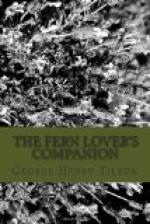[Illustration: Cinnamon Fern, var. frondosa]
Each fertile frond springs up at first outside the sterile ones, but is soon surrounded and overtopped by them and finds itself in the center of a charming circle of green leaves curving gracefully outwards. In a short time, however, it withers and hangs down or falls to the ground. The large, conspicuous clusters of cinnamon ferns give picturesqueness to many a moist, hillside pasture and swampy woodyard. In its crosier stage it is wrapped in wool, which falls away as the fronds expand, but leaves, at the base of each pinna, a tiny tuft, as if to mark its identity.
[Illustration: Cinnamon Fern, var. incisa (Maine)]
Many people in the country call the cinnamon fern the “buckhorn brake,” and eat with relish the tender part which they find deep within the crown at the base of the unfolding fronds. This is known as the “heart of Osmund.” The fern, itself, with its tall, recurving leaves makes a beautiful ornament for the shady lawn, and like the interrupted fern is easy to cultivate. The spores of all the osmundas are green, and need to germinate quickly or they lose their vitality. Common in low and swampy grounds in eastern North America and South America and Japan. May. Some think it was this species which was coupled with the serpent in the old rhyme,
“Break the first brake you see,
Kill the first snake you see,
And you will conquer every enemy.”
[Illustration: Osmunda cinnamomea, var. glandulosa (From Waters’s “Ferns,” Henry Holt & Co.)]
Var. frondosa has its fronds partly sterile below and irregularly fertile towards the summit.
Var. incisa has the inner pinnules of some of the pinnae more or less cut-toothed.
Var. glandulosa has glandular hairs on the pinnae, rachis and even the stipes of the sterile frond. This is known only on the coastal plain from Rhode Island to Maryland.
III
CURLY GRASS FAMILY
SCHIZAEACEAE
CURLY GRASS. Schizaea pusilla
Small, slender ferns with linear or thready leaves, the sterile, one to two inches high and tortuous or “curled like corkscrews”; fertile fronds longer, three to five inches, and bearing at the top about five pairs of minute, fruited pinnae. Sporangia large, ovoid, sessile in a double row along the single vein of the narrow divisions of the fertile leaves, and provided with a complete apical ring. (Schizaea, from a Greek root meaning to split, alluding to the cleft leaves of foreign species.)
[Illustration: Curly Grass. Schizaea pusilla]
The curly grass is so minute that it is difficult to distinguish it when growing amid its companion plants, the grasses, mosses, sundews, club mosses, etc. The sterile leaves are evergreen. Pine barrens of New Jersey, Grand Lake, Nova Scotia, and in New Brunswick. Several new stations for the curly grass have recently been discovered in the southwest counties of Nova Scotia by the Gray Herbarium expedition, mostly in bogs and hollows of sandy peat or sphagnum.




